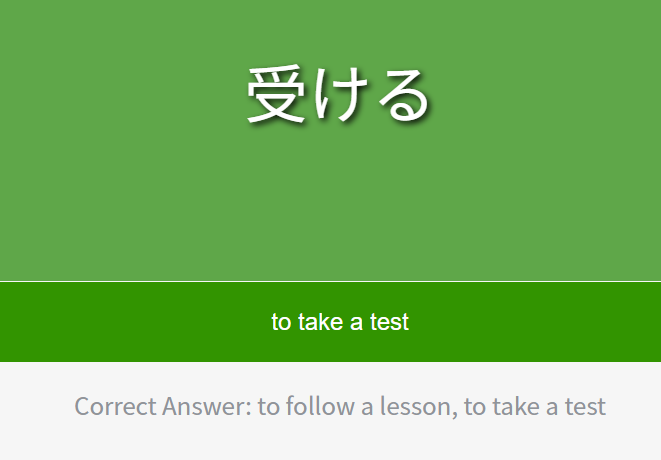Hi all JLPT exam takers!
Please use this thread to discuss anything related to the official Kitsun N4 community deck.
Topics can include:
- General Feedback & Discussion
- Synonym requests
- Fixes
- Suggestions
We hope you enjoy the deck!

Hi all JLPT exam takers!
Please use this thread to discuss anything related to the official Kitsun N4 community deck.
Topics can include:
We hope you enjoy the deck!
I was going through the deck to hibernate all the cards I knew. To quickly run through it, I just spam clicked “Load More” until everything was visible and I could check through them. But at the end, there are just loads of blank/empty cards.
(I’m assuming this is related to what I mentioned earlier on the WK thread, but you can very easily accidentally make blank cards just by hitting “Save” again when building new cards.)
Actually, it’s a different problem  At the end of every jlpt deck, there are kana-only words. It seems that those kana cards are actually not using the correct layouts so they display empty. Pretty big bug!
At the end of every jlpt deck, there are kana-only words. It seems that those kana cards are actually not using the correct layouts so they display empty. Pretty big bug!
Putting it on the priority bugfix list!
Wouldn’t it make sense to add furigana to words that use kanji above the intended JLPT level? Because JLPT N5 and N4 include vocab with kanji from higher levels (didn’t check all of them, but at least kanji from N3 and N2 are very common). That makes it harder to study the vocab for the JLPT.
(Easy examples: 探す - contained in the N4 deck (which is correct). The kanji 探 is listed as N3 on Jisho though - so an N4 student is more likely to encounter it in kana or kanji + furigana anyway. Granted, there’s some overlap between JLPT levels, because of the different difficulties used. A better example might be 枝. That’s an N2 level kanji. Or 掛ける. Using an N1 kanji)
The vocab is considered N4 level, but the individual kanji is not. I’m not 100% sure whether the JLPT adds furigana (pretty sure they do)?
But considering you are also being tested on reading, I kinda think it’s a non-issue as you are already learning the furigana part through that?
I don’t really learn something new from this deck, just testing a bit how it works. 
I’m generally adding a lot of synonyms, coming from WK gives you some expectations for acceptable answers.
I’m posting because I found something that is definitely wrong, “生活する => せいかっする” should be せいかつする.
Yes, but that’s kinda my point. It makes one study more than what is needed for the exam 
Thanks, I’ll put it on the list of things to fix asap 
I’d argue that knowing the reading is just as important to your overal studying, regardless of whether it’s really important for the JLPT exams though 
Of course they are, but these decks are supposedly for test preparation 
It’s not a huge deal though, obviously.
I was using my phone for once, and found that the wrapping is super weird.
I think the upper subtitle (meaning here probably) was still stuck under the address bar for subsequent cards …
I have to update the deck to use the newest version of the layouts. I think that should fix it.
Fixed it 
(The wrong vocab was fixed a while ago btw)
Is there a reason why 受ける has been translated as so? It doesn’t appear as any of the definitions on jisho, and I’ve never came across it in this context outside of 受 being used in 受験 (taking a test/exam):

It’s because the source of the deck is the following list (although with quite some curation done by me and hine):
Apparantly this is how that word occured on most of the tests for the N4 back when the official vocab lists were still being supplied.
Oh right, okay thanks!
I guess I’ll just have to trust that this will be what comes up in the test
I don’t mind adding synonyms/extra info for the card though. If you see it again, could you “propose changes” (from the bottom left actions dropdown). That way I’ll be able to quickly update it. You don’t need to change anything, just flagging it this way is enough 
Hi! I’m working through this deck now, but I’m having trouble with the katakana words.
When I try to do English -> Japanese for the katakana words, it marks hiragana readings as wrong (which I can understand why I think, if you use this deck to study how to write them), but I don’t know how to type the words in katakana to match.
Is there a way/type setting native to Kitsun that allows for that? Or a quick and easy way to swap my keyboard to katakana? Thanks
@cafeolea, Assuming you’re using a computer, all’s you have to do is hold shift while typing letters to convert them into katakana. Personally what I do though is activate caps lock while writing the katakana. I would imagine it’s the same way on phones.
This is literally life-changing information, thank you so much!!! I’ve been using autocorrect for ages.
Glad it’s all figured out 
I might add a hint/note somewhere that describes how the kana conversion works, I can understand the confusion! Or perhaps add a card at the start that explains it all.
Thanks @Buscadon for the help 
P.s. this is the thread for the old N4 deck that has since been replaced with the newer N4 deck, so it contains some very outdated information. I’ll update the title accordingly!